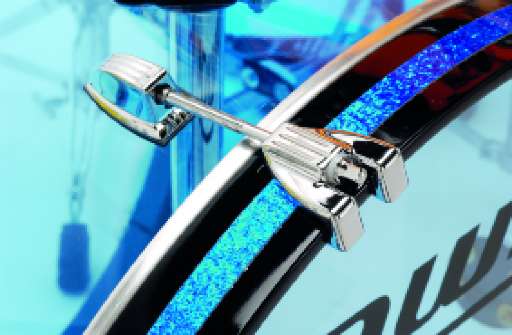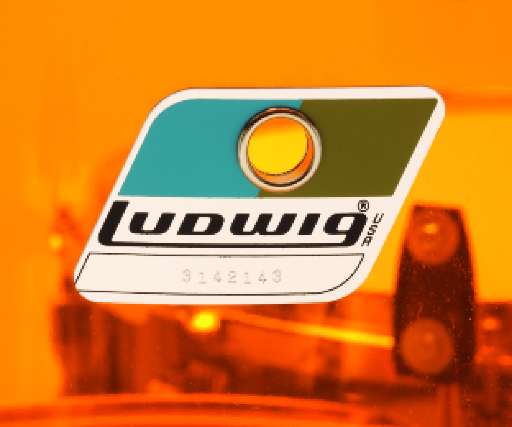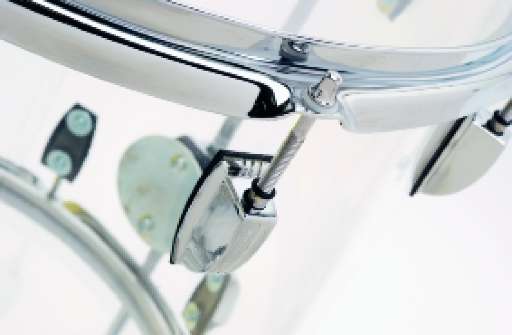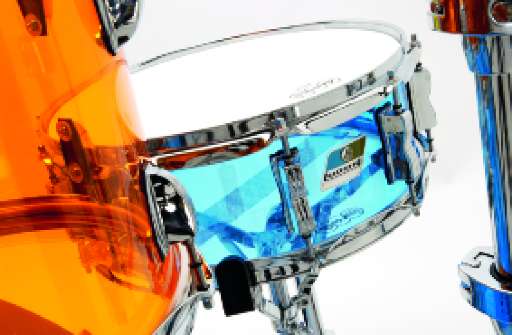MusicRadar Verdict
While the Bonham reissue is aimed at a particular niche, it's evident from the range of colours and sizes that Ludwig is serious about reaching a wider audience. The Vistalite kit is loud, hard and penetrating, which will appeal to many drummers.
Pros
- +
The stunning looks ensure that you will be the centre of attention for a change.
- +
Custom options with unique visual and sonic impact.
Cons
- -
Despite being loud, the Vistalite has a quite specialist sound.
MusicRadar's got your back




The original Ludwig Jellybean drum set featured six colours, this reissue sticks with the most popular four; blue, clear, amber and yellow. The review kit comprises a 22"x16" blue bass drum, 13"x9" amber hanging tom, 14"x14" clear and 16"x16" yellow floor toms, each with three legs, and a 14"x5" blue snare drum.
In the '70s, the Jellybean had single-headed concert toms, but in keeping with today's fashion the reissue is double-headed throughout.
Plastic fantastic
Vistalites are only ever going to be a small volume line as the cost of petroleum derived materials (ie acrylic) remains high. Vistalite shells are also to all intents hand manufactured, so don't imagine plastic means cheap. Still, when you tot it up, a kit is roughly the same price you'd pay for a professional level kit with wooden shells.
The review kit is two-and-a-half grand, including the snare drum, which is not unrealistic for a professional five-shell pack. You can pick from a good range of sizes and have them in whichever colour you like. They're essentially made to order so you may have to wait 12 weeks or more. Stands and pedals are extra.
Vistalite shells are made from oblong sheets of ¼" (6.35 mm) thick acrylic, heated in a sort-of pizza oven until they become malleable, and then pressed into circular moulds. The very first Vistalites had fiat-on butt joins which weren't too clever. So Ludwig soon changed to a 'V' section channel which allowed more epoxy glue to be used.
For the reissues Ludwig has gone back to the butt join but this time with a 1/3" wide, full-length binding strip of matching plastic fixed to the inside. It's not as neat as the 'V' channel but you have to look closely to see it. The ¼" plastic is pretty hefty and cracking looks unlikely.
Want all the hottest music and gear news, reviews, deals, features and more, direct to your inbox? Sign up here.
The plastic is certainly substantial and the drums feel heavier than most wood shell equivalents. One advantage of moulded plastic is that the bearing edges are super smooth.
Classic lugs
The lugs are Ludwig's familiar Classics, isolated from the shells by black rubber gaskets. Ludwig has chosen to use the smaller version of the Classic lug all around, even on the bass drum. Presumably this is in keeping with today's obsession with minimum shell contact.
Each tuning rod has a small rubber washer which prevents the lugs dropping out when you change heads. The bass drum has wooden hoops inlaid with blue glitter just like the original.
The snare drum is 14"x5", fitted with 10 Classic lugs again, though this time double-ended. These lugs are also mounted on rubber isolating gaskets.
The strainer is Ludwig's trusty side-lever P85. It's basic but works and has a strap attachment rather than cord. The Bonham reissue bass drum retained the '70s curved, disappearing spurs. This bass has modern fold-out spurs which work much better. Also, the Bonham kick had no centre tom mount (although Bonham's did) but the Jellybean bass drum does - a ball-and-clamp post with a single 'L' arm, which slots into the receiving block on the mounted tom.
The tom itself is fitted with a Ludwig RIMS-style bracket. It's isolated by a large piece of felt. The wing nuts on the tom mount and receiving block are a little too close for comfort.
The leg receiver blocks on the floor toms have thick nylon gaskets isolating and pushing the legs out from the shell so they don't catch the rims.
Sonic appeal
Playing the kit live, the sound is unmistakably different to wood or metal drums. In particular, the snare drum was piercing. The original '70s Vistalite snares had flat bearing edges which detracted somewhat from the sound. But this snare has proper 45º bearing edges, so there are no tuning or projection problems.
The snare sound is dry but not dull. Quite the opposite, in fact. The response is lively towards the edges and thick in the centre, so you really don't need damping, although a bit of Moongel will nip off the over-lively edge. Cross-stick sounds benefit from the crisp response and are clean and toppy. Rim shots crack fiercely.
The toms have a hard, direct and contained sound. There's less attack than with the snare drum, as the middle frequencies seem to dominate resulting in warmth and body, although things can get a bit muddy. The bass drum is like a cannon, with a fantastic impact and more of the deeper frequencies. The dry sound meant the drum was less boomy than a wood drum, even without damping.
MusicRadar is the number 1 website for music makers of all kinds, be they guitarists, drummers, keyboard players, djs or producers...
GEAR: We help musicians find the best gear with top-ranking gear round-ups and high- quality, authoritative reviews by a wide team of highly experienced experts.
TIPS: We also provide tuition, from bite-sized tips to advanced work-outs and guidance from recognised musicians and stars.
STARS: We talk to musicians and stars about their creative processes, and the nuts and bolts of their gear and technique. We give fans an insight into the actual craft of music making that no other music website can.
